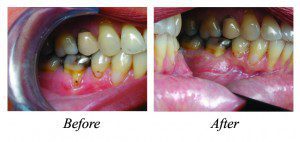By Juan Teodoro, D.M.D.
 Exposed tooth roots are the result of gum recession. Gum recession is a common dental problem found in nearly 15% of the adult population. There are many causes of gum recession, including periodontal disease, aggressive tooth brushing, anatomic susceptibility and tooth position. Other factors such as genetics and teeth grinding have been identified as contributors to gum recession. Untreated gum recession leads to esthetic compromises. If recession progresses without treatment; it ultimately leads to root sensitivity, loss of supporting bone, tooth decay and tooth loss.
Exposed tooth roots are the result of gum recession. Gum recession is a common dental problem found in nearly 15% of the adult population. There are many causes of gum recession, including periodontal disease, aggressive tooth brushing, anatomic susceptibility and tooth position. Other factors such as genetics and teeth grinding have been identified as contributors to gum recession. Untreated gum recession leads to esthetic compromises. If recession progresses without treatment; it ultimately leads to root sensitivity, loss of supporting bone, tooth decay and tooth loss.
Two Types of Gum Tissue
In the mouth, there are two types of gum tissue. The first is a dense, bright pink gum collar found around the neck of the tooth (the keratinized or firm gum). This gum tissue is similar in consistency to the skin on the palms of ones hands. The purpose of this tissue is to protect the teeth and to keep the gum tissue from receding. The second layer is a loose, movable type tissue that has no protective properties at all (loose gum or mucosa).
When the firm gum layer is damaged, the underlying bone will dissolve away exposing the root surface of the teeth. This will commence the cascade for susceptibility to root decay, tooth sensitivity, bone erosion and tooth loss.
Gum Grafting: An Excellent Treatment Option
Gum grafting is aimed at covering the exposed tooth root surface. It is an excellent way to restore natural symmetry to the gum and make the smile look more aesthetically pleasing along with strengthening the tooth for long term retention and health.
Traditionally, a gum graft required removing gum tissue from the roof of the mouth (palate) and repositioning to the areas of recession. Now, instead of using the patient’s own gum tissue, a tissue bank allograft uses tissue from a cadaver for the graft. By using a donor’s tissue, the patient does not have to go through the pain and recovery of the palate healing post-surgery. Tissue from donors is safe and effective.
Other gum grafting alternatives offered by Dr. Teodoro’s Team are the successful use of synthetic grafting engineered regeneration proteins and growth factors. These proteins mimic the biological processes of natural tooth development. They are engineered to stimulate wound healing and regeneration and do not require the use of the patient’s own gum tissue or an allograft in many cases. This procedure can be done for one tooth or several teeth to restore or even out the gum line in a single visit.
Dr. Teodoro is a Board Certified Periodontist. He holds both Diplomate status in the American Academy of Periodontology and the International Congress of Oral Implantologists. Dr. Teodoro is an Adjunct Professor to the University of Pittsburgh School of Dental Medicine. He is also a Clinical Assistant Professor at the Naples Dental Residency Program for the University of Florida. Dr Teodoro served as a Major in the United States Air Force practicing Periodontics. Throughout his Air Force career he served as the Chief of Periodontics, Director of the Implant Board & Clinical Instructor. Dr. Teodoro is one of the local leading authorities in Laser Periodontal Therapy and in the Brånemark method of Implantology. He was the first Periodontist in both Lee and Collier county to bring Periodontal Laser technology with the PerioLase Laser for the treatment of Periodontal Disease.
Bonita Periodontics & Implants
239-333-4343
www.bonitaimplants.com








